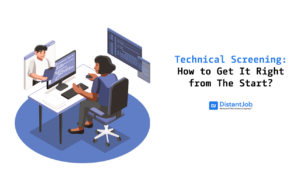The importance of data security and organization for companies, whether remote or not, has increased the relevance of both database architects and database administrators. But have you ever wondered what the difference is between these two roles? Here’s what you need to know.
Database Architect vs. Data Architect – The Key Differences
While there is some overlap between both jobs, there is a major difference between database architects and database administrators.
Database architects (DA) plan, design, and develop the architecture of a database system, while database administrators maintain and operate the existing database systems. Database architects must have a high level of technical expertise, as they are responsible for ensuring the most efficient and secure data systems. Database administrators (DBA), on the other hand, must have the ability to manage and use the system, as well as troubleshoot any technical issues that may arise.
Let’s go into more detail about each role.
Put simply, a DBA manages the existing databases, while database architects design new databases.
What is a Database Architect?
If your data isn’t organized or secure, it’s impossible to make use of that data efficiently. This is when a database architect comes into the picture.
A database architect’s job is to create and design a database that suits a company’s various needs. They begin by studying and analyzing their employer’s priorities, goals, and needs and then proceed to assess the current data infrastructure and determine where changes must be made. To do so, they:
- Develop the models needed to ensure both scalability and security and then implement and test them.
- Ensure that the database meets any regulations and standards when dealing with sensitive data.
- Create technical documentation pertaining to a database’s functionality, its ancillary tools, and how they work together to provide all the needed functionality.
In simpler words, they map out how the database should look and work.
What does a Database Architect do?
The role of a database architect involves designing and managing database systems for organizations, focusing on creating efficient, secure, and scalable solutions.
Roles and Responsibilities
A database architect works closely with software designers and analysts to develop comprehensive, easy-to-use databases. They first understand the company’s main needs, and current data infrastructure, and then seek the best database model and type and start creating it and making the necessary changes.
Their main responsibilities are:
- Design effective database solutions and models for a company/client.
- Identify database structural necessities by evaluating client operations and applications.
- Prepare database architecture reports for management teams.
- Install and organize information systems to guarantee functionality, security and scalability.
- Monitor closely how the system is performing by doing tests, troubleshooting, and integrating new features.
Database architect skills:
- Applied math and statistics
- Data visualization and data migration
- Database Management System (DBMS) software
- Programming languages (SQL, Python, and Java)
- Design skills
- Cloud architecture and integration
Types of Database Architects:
There are several database architects, each specializing in different aspects of database design and management. Here are some common types:
- Enterprise Database Architect: Focuses on designing and managing the database architecture for an entire organization. They develop strategic plans for data storage and usage across various departments.
- Data Warehouse Architect: Specializes in designing data warehouses for analytics and business intelligence. They work on integrating various data sources into a centralized repository for reporting and analysis.
- Database Solution Architect: Concentrates on developing specific database solutions to meet business requirements. This might involve customizing database systems for particular applications or user needs.
- Cloud Database Architect: Specializes in designing and managing databases in cloud environments. They work with cloud services like AWS, Azure, or Google Cloud Platform to build scalable and efficient cloud-based database systems.
- NoSQL Database Architect: Focuses on NoSQL databases, which are used for large data sets and real-time web applications. They design and manage databases that do not follow the traditional table-based structure.
- Big Data Architect: Works with big data technologies and architectures, focusing on managing large volumes of unstructured data. They often work with tools like Hadoop and Spark.
What is a Database Administrator?
Building and creating a database is one thing. Managing and organizing data is a completely different thing.
The role of a database administrator (DBA) consists of using the latest technological tools to store and organize an organization’s critical data. They ensure that a company’s database is secure and accessible.
It’s important to highlight that DBAs are a key element for businesses that work with big chunks of data. They not only make sure that the data is in the right places and that everything is organized, but they also help businesses make strategic plans. The database administrator helps coordinate the system’s data analysts use to translate numbers into business plans.
What does a Database Administrator do?
A Database Administrator (DBA) is responsible for the performance, integrity, and security of databases.
Roles and Responsibilities:
Their main responsibilities are:
- Installation and Maintenance: Installing and upgrading database servers and application tools.
- Setting Up Databases: Creating and maintaining databases according to the needs of users and applications.
- Data Management: Ensuring the databases are available to all relevant users and are secure from unauthorized access.
- Performance Monitoring: Monitoring database performance and implementing changes for improvement.
- Backup and Recovery: Implementing and testing backup and recovery plans to ensure data integrity and availability.
- Security: Managing database security, creating and maintaining user access permissions and privileges.
- Troubleshooting: Identifying and resolving any issues related to databases.
- Data Modeling and Design: Working on the design of database structures, data modeling, and schema refinement.
Database administrator skills:
- Knowledge of database design
- Understanding of relational DataBase Management Systems (DBMS)
- Structured Query Language (SQL or Transact-SQL)
- Analytical and problem-solving skills
- Data security
- ERP and business knowledge
Types of Database Administrators:
Database Administrators (DBAs) can specialize in various areas, reflecting the diverse needs of database management. Here are some common types:
- System DBA: Focuses on the physical and technical aspects of database management, such as installing and upgrading the database servers, ensuring efficient performance, and managing backups and recovery plans.
- Application DBA: Works more on the application side of databases, dealing with database integration for specific applications, ensuring that the database supports application requirements, and managing data and database structures related to specific applications.
- Database Warehouse Administrator: Specializes in managing data warehouses. This involves handling large volumes of data, optimizing data retrieval, and ensuring data warehouse systems work efficiently with other business intelligence tools.
- Network DBA: This position focuses on managing databases in networked environments. It ensures that databases across a network are optimized for performance and security.
- Cloud DBA: Specializes in managing databases in cloud environments. They work with cloud-based database services, ensuring the scalability, availability, and security of databases in the cloud.
- Performance DBA: This position focuses on optimizing database performance. They analyze, troubleshoot, and improve database performance and efficiency.
- Security DBA: This position concentrates on securing the database. This involves setting up robust security protocols, monitoring for security breaches, and ensuring compliance with data protection regulations.
Database Architect vs. Database Administrator: Table of Comparison
Knowing which role is better for you consists mainly in understanding their key differences.
At first glance, we can say that a database architect builds and improves the database of a company, while a database administrator focuses more on the organization and the management of such a database. However, there’s more to it.
Here are the main differences between a database architect and vs database administrator:
| Comparison | Database Administrator (DBA) | Database Architect |
|---|---|---|
| Main Role | Manages and maintains database systems. | Designs and structures database systems. |
| Key Responsibilities | – Installs and upgrades databases. – Ensures data integrity. – Manages backups and recovery. – Optimizes database performance. – Ensures database security. | – Designs database schema and structure. – Integrates databases with applications. – Optimizes database for scalability and efficiency. – Ensures data modeling aligns with business needs. – Develop database solutions and strategies. |
| Skills Required | – Database management – Backup and recovery techniques – Performance tuning – Security measures – Knowledge of SQL and database-specific languages | – Data modeling – System design and architecture – Knowledge of SQL and other database languages – Understanding of business processes – Big data and cloud technologies |
| Tools & Technologies | SQL Server, Oracle, MySQL, backup and recovery tools | Data modeling tools, SQL, NoSQL, cloud database services |
| Focus Area | Operational efficiency and security of existing database systems | Strategic planning and design for new database systems |
| Typical Challenges | Handling data recovery, ensuring uptime, managing performance issues | Balancing technical and business requirements, adapting to new technologies |
| Career Path | Progresses to senior DBA roles, potentially to database management | Can progress to senior architect roles, data strategy roles |
Conclusion
In conclusion, while both Database Administrators (DBAs) and Database Architects play crucial roles in the management and design of database systems, their responsibilities, skill sets, and focus areas significantly differ. DBAs are primarily responsible for the operational management and maintenance of databases, focusing on aspects like performance tuning, security, and data recovery.
Database Architects, on the other hand, are more involved in the strategic planning and design of database structures, ensuring scalability, efficiency, and alignment with business needs.
Understanding these differences is vital for any business looking to effectively allocate resources and responsibilities within their IT departments, ensuring both the efficient operation of existing systems and the innovative development of new database solutions. And if you need to hire for any of these two position, you are in the right place.
At DistantJob, we take care of all the steps for you to hire the perfect database administrator or architect. We have a team of highly qualified IT recruiters looking for a candidate with the skills and capabilities you’re looking for.
We’ve been matching companies with tech candidates for more than a decade, so if you need a hand looking for your ideal candidate, we are your people! Plus, we not only headhunt great candidates, but we also take care of all the HR aspects. Contact us, and let us help you find the right data expert your company needs.





